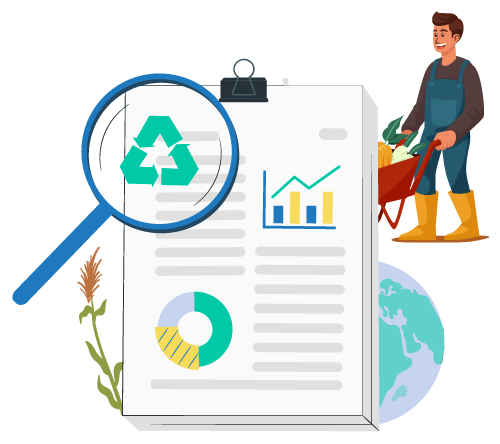Content Marketing In Agriculture Agency Industry
The best content marketing strategy tips for agriculture and food businesses. Learn how to build a content strategy from the ground up and increase revenue!
How to Create a Content Marketing Plan

From autonomous tractors to imagining what farming in space will be like to adjusting to fluctuations in climate and environment, there is no shortage of evolution happening in the agriculture sector. With constant changes and innovations, agriculture businesses must also evolve in the way they connect with potential strategic partners and consumers to stay ahead in a changing world.
Content marketing is the most effective way to stand out and connect with the audience that will help you reach your marketing goals.
Why Content Marketing Is Important For Your Agriculture Business

To stay competitive in any industry, it's critical to stay top of mind with your ideal customers. The potential for symbiotic partnerships in the agricultural industry is massive and you want to have a way for partners to vet you and know that you are a trusted authority.
Content marketing is an effective means of reaching highly-targeted populations and eventually converting them into your customers or partners using your website, social media, and other forms of content such as podcasts, videos, ebooks, white papers, and webinars.
When building your content marketing strategy, you must adopt a long game mentality, not unlike the mentality that farming requires. You plant a seed. You water that seed and nurture it every single day. When the time is right, the seed will eventually grow into a fruit or vegetable-bearing plant. That's how it will go with your audience. You start to grow your audience and nourish it every day through different means of digital marketing.
As your content begins to take hold with your audience and in search engines, you will see a noticeable improvement in conversions on your website. It's a symbiosis that takes time and the businesses that put in the time and consistency to build their online presence have the joy of being able to not only harvest crops but more revenue as well.
Businesses who invest in content marketing report numbers that are a clear indicator of why the effort is well worth it:
- 60% of businesses report content marketing generates leads
- Content marketing costs 62% less than outbound marketing and generates 3X the sales
- 70% of people prefer to get their information from blogs than traditional media
Advantages Of Content Marketing For Your Agriculture Business


The internet allows you to connect with anyone else who's online and content marketing helps you build the bridges to your ideal customers and partners.

Social media is an amazing tool that helps your audience develop a meaningful relationship with you. More and more, consumers are looking to connect with brands on an emotional level, and your social platforms are the perfect place to do that.

Branding is important. It creates a psychological stamp in the mind of the consumer that builds an automatic association when it comes to who to buy from for certain things. When most consumers are thinking of a new running shoe, Nike or Adidas will likely come to mind at some point in the buying cycle. Their brand is ever-present and has consistently promoted awareness of their products and ideals over the decades. Even though it takes some serious time to catch up to that awareness, the power of branding can be leveraged to your advantage as well.

Organic traffic is website traffic that you're not paying for through ads. Organic traffic is part of a comprehensive SEO strategy as the search algorithms favor websites with superior content by placing them higher in search results. When you post compelling blog posts, videos, or other content and promote it through well-written social media posts with strong calls to action, it's a winning recipe for increased organic traffic.

Your customers are looking for leadership, whether they know it or not. Being a part of the agriculture industry, you have a profound opportunity to stand out from the competition and offer educational content in an area that hits a primal nerve for your audience.

With traditional outbound marketing, the goal is to create a sales lead or a sale from the advertising. As mentioned before, with content marketing, the seeds that you sow will reap a bountiful harvest over the long haul. It's different from traditional advertising because the majority of content is to provide value, not to "sell" anything. However, as your audience and authority build, the times you do go for the sale, the more people will click "buy."

. Email marketing is important because depending solely on search or social media for audience communication is an incomplete strategy. Email marketing allows you to continue to add value, promote any content, and get the word out about promotions and sales to existing customers and contacts in your funnel.
Content Marketing Case Studies in the Agriculture Industry

Moink.com is a meat delivery service that, according to their website, is fighting for the family farm. They have gained favor from Shark Tank cast members and there is a buzz on outbound marketing channels such as podcasts about their service and product. In this case study, we'll take a look at what they're doing right and where they have an opportunity to improve their content marketing strategy.
Brand Clarity
A quick visit to their website immediately lets the visitor know who they are, what they do, and what their values are. Above the fold, you see the message, "Enjoy the highest quality meat and help us fight for the family farm."
Immediately this appeals to a consumer values system, letting the visitor know that they are going to get good meat raised on a family farm. What this doesn't say explicitly is that the meat they'll consume is not from a factory farm where animals are treated poorly. This immediately taps into an emotional values system, and if Moink's ideal customer is the one visiting the website, they're likely to resonate with this content.
The website is an important cornerstone of content marketing; your content should serve your audience and answer any questions they have about your company, products, or services.
Product Clarity
It's all well and good to have common values systems, but if the customer doesn't know what Moink's offer is, then they can't click "buy" with confidence. This is a problem because it's safe to say that a confused mind doesn't buy. However, scrolling a little further down on Moink's the customer is greeted with a clear idea of exactly what they'll be getting when they purchase from Moink.
From their website:
"Meat subscription boxes. From family farms. Grass-fed and grass-finished beef & lamb, pastured pork and chicken & wild-caught salmon."
It's pretty clear what the customer is in for when it comes to the website.
Moink's Social Media Strategy


We won't go into a comprehensive look at Moink's social media and instead focus on Instagram. Keep in mind that when you're first starting your content marketing, it's a good idea to identify which social media platforms your target market hangs out on and focus on just one or two
Moink might have a different presence somewhere besides Instagram, but a quick look at their profile shows they've spent some time creating good content and have invested in Instagram as a platform.
So what's working?
When you first visit their Instagram, you'll see that it's visually cohesive and draws in the visitor. Their content is informative and high value, with posts that show you how to prepare your salmon or any other food. These are topics keeping in line with their offers, creating cohesion between the type of information their consumers want and the products they offer.
They have a little under 10,000 followers. In the world of "influencers," this would not be considered a big number at all, but if you're targeting qualified audience members, it's less important to have a huge following. Think quality over quantity. It would be difficult to know whether they've connected with a high-quality audience on Instagram without looking at their analytics, so we can't draw any conclusions on whether or not that is working.
Where is there room for improvement?
At the time this is being written, the last post was posted four months ago. Think about planting a seed and then not watering it for four months, and it should be clear why the radio silence on Instagram is a problem.
Another place where Moink is missing a major opportunity is its lack of a blog. There is no shortage of topics they could write about to educate their audience about ethically consuming meat and the importance of supporting small farmers. Writing blog posts around keyword research and search volume in this space would serve to achieve the holy grail of organic traffic to their website.
If a blog wasn't their cup of tea, a podcast would be another great way to connect with an impassioned audience.
As a note, content marketing isn't something that a business will perfect immediately. It's an evolving process that shifts with Google analytics, technology, and your industry climate. Even though Moink is missing some opportunities, it doesn't mean that they can't catch up.
Creating A Content Strategy That Works

We just mentioned that you don't perfect a content strategy, but there are basics that every company should have in place as well as principles to adhere to that will help you win the game in the long run.
What You Need
We'll start with bare-bones basics of what you need to get started.

If you don't have a website already, it's time to get one. A website gives you your little corner of the internet that you control, as opposed to social media platforms that are privy to regulation, evolving policy, and other antics.
There are plenty of website builders that allow you to use drag and drop technology, making it easier than you might imagine building a beautiful website. Research which platforms have the integrations and capabilities you need before committing to one. A few different website builders to check out are:

As previously mentioned, email is a key building block for your content marketing strategy. Some website builders offer email capabilities, but if yours does not, check out these widely-used and trusted options (all with different price points and levels of sophistication):

Social media is the key to "planting the seeds" with potential customers, and every social media platform is different with different advantages and limitations. If you're just getting started with content marketing, research which social media platforms your ideal customers tend to hang out on and focus on one or two platforms to get started.
Consistency is key, and trying to be on every platform is a sure-fire recipe to burn yourself out and fail to leverage the potential connection waiting for you.

A free opt-in is a piece of content that you offer in exchange for an email address so you can build your email database. It could be anything, as long as it's something simple, digestible, and authority-building so the person opting into your offer is more likely to open your emails and visit your blog or social media.
Examples include:
- An explainer video of the difference between cage-free and pasture-raised chickens
- A PDF guide on selecting produce without pesticides
- An exclusive "family recipe" for a pot roast
How To Get Started

Once you have your building blocks in place, it's time to take action! Here's how to get started with your content marketing strategy.
Establish Your Brand Identity
If you don't know who you are as a brand inside and out, your customer has no chance of understanding and connecting with you at that emotional level. If you've not yet fleshed out your brand identity, take some time to answer the following questions:
- What is our offer?
- Why is that what we chose to offer?
- What is our mission, vision, and values?
- What problem do we solve?
- What is our brand voice (casual or formal)?
- Who do we want to serve?
- What are our goals as an agriculture business?
Get Clear on Your Content Marketing Goals
InUse the SMART goals format to create goals that you can accurately measure and therefore understand whether your content marketing strategy is working or if it needs improvement.
SMART is an acronym that stands for:
For example, increase Instagram following by 1,000.
Saying you want 1,000 new followers as opposed to "more followers" is measurable.
You have what you need to take action, in this example an Instagram profile and a strategy.
Are you able and willing to put in the time to create high-value content and engage with your audience?
Commitment happens in the calendar. Put a deadline on your goal and communicate that deadline with your team consistently.
Get To Know Your Customer
Knowing your customer makes it easier to build that all-important relationship and start sowing those seeds.
Ask yourself the following questions to better know your customer:
- How old are they?
- Are they usually male or female or both?
- What do they want the most in life?
- What keeps them awake at night?
- What are their aspirations?
- What clubs do they belong to?
- What are their favorite social media platforms?
- Where do they get their information?
Do Your Research
Find out who your competitors are either with a Google search, on social media, or on YouTube (or all three). Look at what they're doing well and learn from it. Conversely, look at what isn't working and learn from that as well.
By checking out your competitors, you can discover long-tail keywords from competitors showing up high on search results, the search volume of certain keywords, winning on-page SEO strategies, what blog posts are popular, and what type of social media posts yield the most engagement.
Decide What Content to Create
Now that you have your basic content marketing building blocks nailed down, know who you're talking to, who you are and what you have to offer, and what problems you're solving in the marketplace, it's time to start brainstorming content ideas.
This is where you get to be creative and have fun. Remember that it will take some time to see what works and what doesn't, so you need to play the long game. Hopefully, your research has provided you with significant inspiration, and you have an idea of what type of content you would like to create.
In summary, however, examples of content you can create for your agriculture business include:
- Blog posts
- Visual demographics
- Webinars
- Social media posts
- Videos
- Livestreams
- White papers
- Contests and sweepstakes
- Quizzes
- Ebooks
The Final Step: Hiring A Content Writing Pro
Content writers have a unique skill set in that they can write different types of content (long-form blog posts, social media posts, video scripts, etc.) in a way that feels conversational and readable to the customer while also keeping in mind the end goal: click-throughs and ultimately sales conversions. It's a delicate balance, and hiring a skilled content writer will go a long way in watching the seeds you sow yield a harvest on a shortened timeline.
Learn more and browse our team of professional content writers for the agriculture industry
here!



